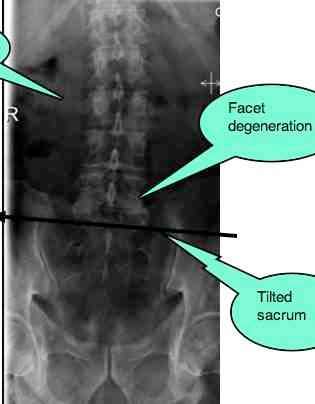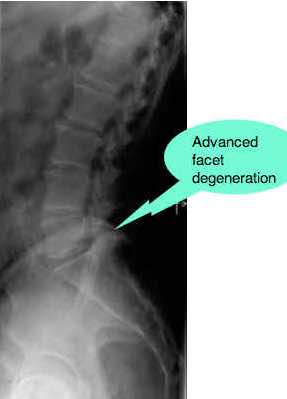- All You Need to Know
Lumbar Stenosis Case file
Lumbar stenosis case file brings you an anecdote from a chiropractor.
This page was last updated by Dr Barrie Lewis on 21st April, 2019.
The typical signs and symptoms of low back and leg pain in the elderly are often not pretty; there may be numbness and even severe weakness in one or more of the muscles; but they are not necessarily the monster they are assumed to be. Given time, it's astonishing what can be achieved with chiropractic help.
Mr S, a 75-year old man, with a decade and a half long history of lower back pain, and with onset of tired, aching legs about 18 months ago whenever he walked more than 50 metres, gave cause for concern. He walked in a stooped manner, in slight flexion, which brought relief from his discomfort.
Extension of his back produced immediate low back pain and bending to the side produced a tingly, numb feeling down his right leg.
He obtained relief from the ache in his legs by sitting and lying down.
My
favourite, the slump test, for a slipped disc was negative. Nor did he
have any bowel or bladder problems which may accompany a severe case of
lumbar stenosis.
Part of his underlying problem was a short left lower limb plus a tilted sacrum that give him a moderate scoliosis. Interesting research about leg length inequality is unequivocal; it produces more arthritis in the knee, hip and low back.
The red label below shows the arthritic facets.

Lumbar Stenosis Case file
A lumbar stenosis case file often has symptoms down the leg with minimal low back pain.
- Read more about the SLUMP TEST for sciatica ...
- HELP FOR SCIATICA PAIN ...
- Leg Length Inequality ...
The label below on your reading left, marked R, says "scoliosis"; done to make the graphic narrower for smartphones.

In Mr S's LUMBAR STENOSIS CASEFILE I was quite certain his short left leg contributed to the arthritis in his low back. How you might ask?

Short leg syndrome
People
with a short leg, and there are a great many of us (I am one), are more
likely to develop fixations in the lower joints, and it is this immobilisation of the joints that is the cause of the degenerative changes that we found in Mr S's lumbar spine.
Medicine's theory
Medicine believes this degeneration in the lumbar spine is the natural affect of aging, call it wear-and-tear. Like grey hair. To an extent this is true, but the full blown degenerative arthritis in the joints of every lumbar stenosis casefile is not normal and natural aging.
Sometimes, this it is indeed the case after trauma like a serious car accident or a fall from a height on the buttocks, or infection. But in the majority, science is now proving that it is joint fixation that stagnates the fluids that lubricate the joint cartilage, causing the prolific arthritis.
Regular, specific exercises, and an occasional but regular Chiropractic adjustment of fixated joints, is what we believe is the correct approach; prevention, long before the wear and tear develops.
Backs are the most strange and unpredictable things. Despite a very poor prognosis, within three weeks Mr S was standing up straight, and could walk several kilometres without the fatigue in his legs. We've started the rehab phase; he's on these exercises every morning for life. They only take 2 minutes; you can get them from Chiropractic Tips.
What did I do? I adjusted his sacrum, lying on his tum, using a Thompson drop protocol, part of the usual Sacroiliac Joint treatment. Then we adjusted the fifth lumbar vertebra which was fixated, lying on both sides. Using a drop technique, it's gentle but firm, with no audible releases. Bob's your uncle. He can walk again.
Remember, this is only an anecdote. Chiropractic can't cure every case of spinal stenosis. In fact, Mr S isn't cured.
I don't believe in cures with backs, any more than one can be cured of diabetes. He must come under management of his back to maintain the progress. He is more than happy, having suffered for 18 months.
Help for Sciatica Pain
Spondylolysthesis (pronounced spondylo-lys-thesis) is the longest word I know in the English language. German can boast of several hundred longer words!
A "spondylo" or "spondy" occurs when a vertebra slides forwards on the vertebra below, sometimes crushing the spinal cord, or the nerve root in the process, causing leg pain, and sometimes weakness and numbness in the legs. Spinal Stenosis.
There are different causes, one of them being degenerating facet joints.
- Lumbar Facet Arthropathy ...
- Lumbar Facet Arthropathy SPONDYLOLYSTHESIS ...
- Help for sciatica pain
Leg pain
There are of course many causes of leg pain and
it would take several long texts to include exhaustively all the
possible causes. For example, I have a relative with a very rare
autoimmune disease. Only six cases exist in the UK; the classic signs are late onset of
asthma and severe vasculitis of the lower legs. It's not included, obviously, in our
list of common causes of leg pain.
There are many exercises that you can do for relieving sciatica; gently and sensibly done they will make a huge difference.
At Chiropractic Help.com we are planning a major upgrade in 2012 with more videos of exercises and sciatica stretches.
Here's an update of interest; it's happening, see below. In the meantime, these chiropractic tips have some basic lumbar exercises, always an important part of sciatica pain cures.
Every successful lumbar stenosis casefile includes a disciplined set of exercises done daily; before getting out of bed is the best time to do them, in my opinion. Just like you brush your teeth, whether they hurts or not; it's called prevention.
- LEG PAIN
- CHIROPRACTIC TIPS ...
- Simple LOWER BACK EXERCISES on video. Done on your bed they take less than two minutes.
Useful links
- More about Sacroiliac Joint treatment ...
- Consulting a Chiropractor ...
- FIND A GOOD CHIROPRACTOR ...
- L4 LUMBAR SPINE ...
- Spinal stenosis explanation
Did you find this page useful? Then perhaps forward it to a suffering friend. Better still, Tweet or Face Book it.
